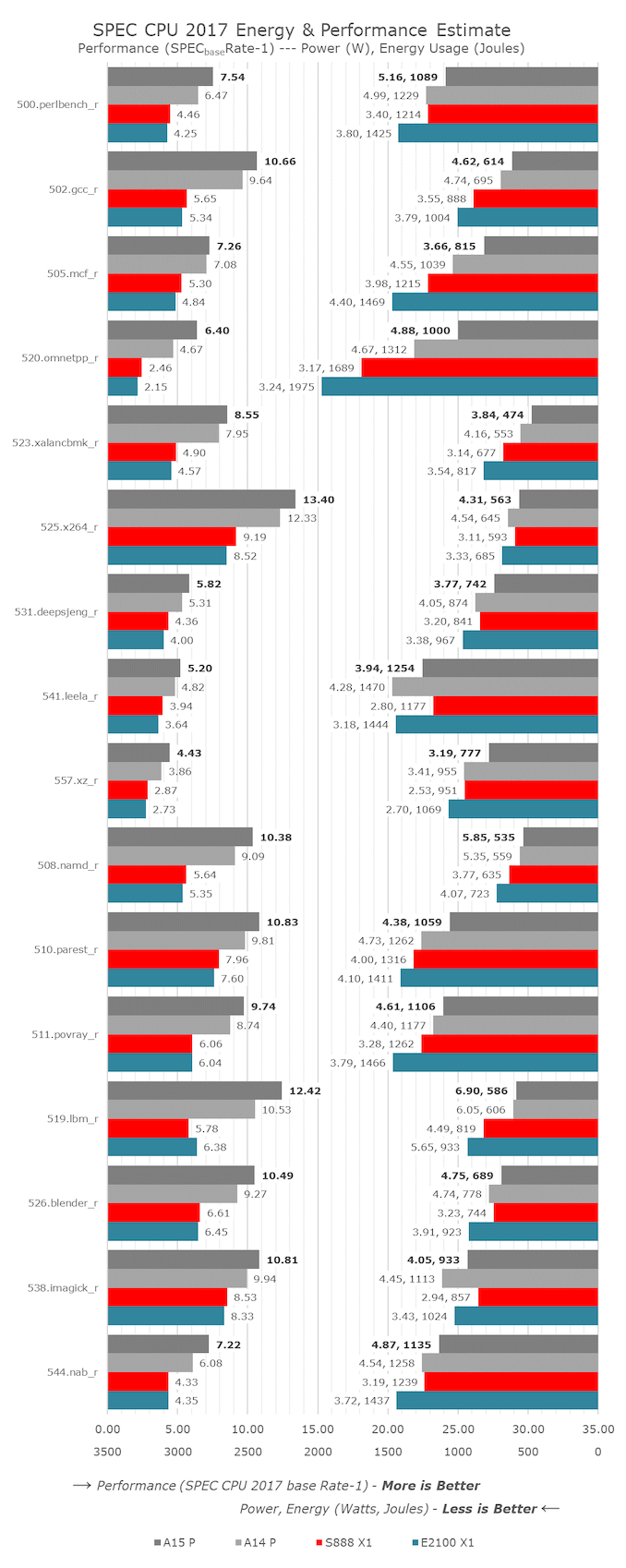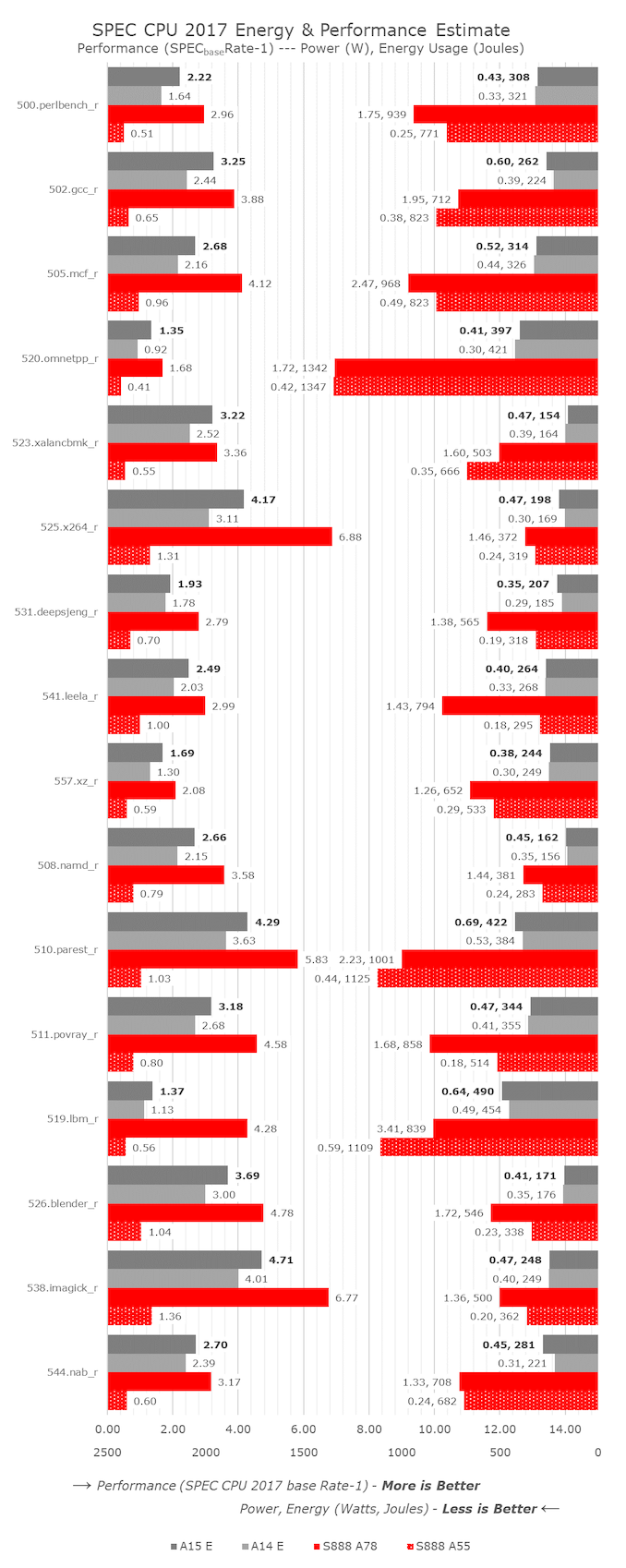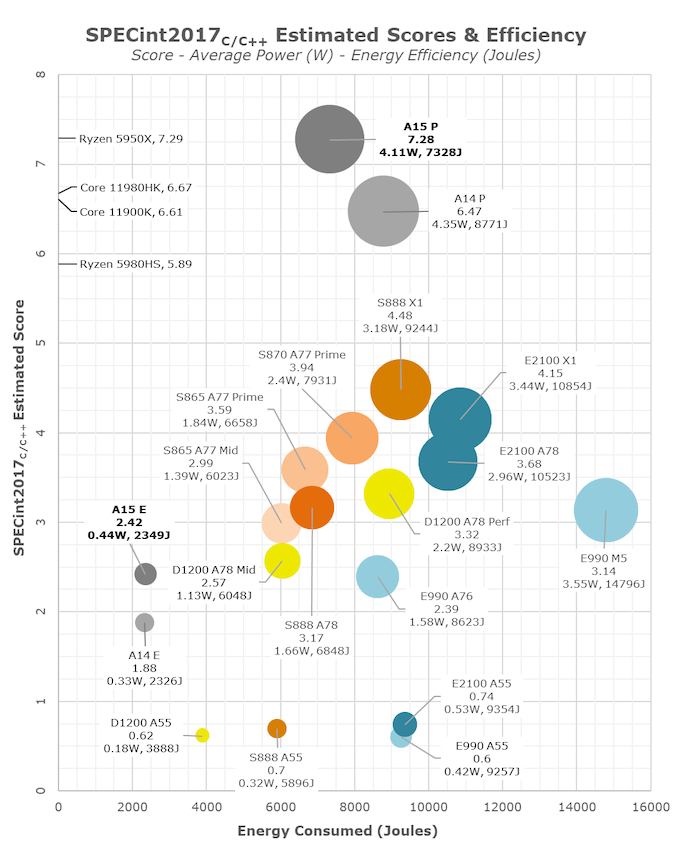The Apple A15 SoC Performance Review: Faster & More Efficient
by Andrei Frumusanu on October 4, 2021 9:30 AM EST- Posted in
- Mobile
- Apple
- Smartphones
- Apple A15
CPU ST Performance: Faster & More Efficient
Starting off with this year’s review of the A15, in order to have a deeper look at the CPU single-threaded performance and power efficiency, we’re migrating over to SPEC CPU 2017. While 2006 has served us well over the years and is still important and valid, 2017 is now better understood in terms of its microarchitectural aspects in its components, and becoming more relevant as we moved our desktop side coverage to the new suite some time ago.
One continuing issue with SPEC CPU 2017 is the Fortran subtests; due to a lacking compiler infrastructure both on iOS and Android, we’re skipping these components entirely for mobile devices. What this means also, is that the total aggregate scores presented here are not comparable to the full suite scores on other platforms, denoted by the (C/C++) subscript in the score descriptions.
As always, because we’re running completely custom harnesses and not submitting the scores officially to SPEC, we have to denote the results as “estimates”, although we have high confidence in the accuracy.
In terms of compiler settings, we’re continuing to employ simple -Ofast flags without further changes, to be able to get the best cross-platform comparisons possible. On the iOS side of things, we’re running on the newest XCode 13 build tools, while on Android we’re running the NDKr23 build tools.
In terms of performance and efficiency details, we’re swapping the graphs around a bit from now on – on the left axis we have the performance scores of the tests – larger bars here mean better performance. On the right-side axis, growing from right to left are the energy consumption figures for the platforms, the smaller the figure, the more energy efficient (less energy consumed) a workload was completed. Alongside the energy figure in Joules, we’re also showcasing the average power figure in Watts.
Starting off with the performance figures of the A15, we’re seeing increases across the board, with absolute performance going up from a low of 2.5% to a peak of +37%.
The lowest performance increases were found in 505.mcf_r, a more memory latency sensitive workload; given the increased L2 latency as well as slightly higher DRAM latency, it doesn’t come too unexpected to see a more minor performance increase. However, when looking at the power and efficiency metrics of the same workload, we see the A15 use up almost 900mW less than the A14, with energy efficiency improving by +22%. 520.omnetpp_r saw the biggest individual increase at +37% performance – power here went up a bit, but energy efficiency is also up 24%.
The smallest performance gains of the A15 are found in the most back-end execution bound workloads, 525.x264_r and 538.imagick_r improve by only 8.7%, resulting in an IPC increase of 0.6% - essentially within the realm of measurement noise. Still, even here in this worst performance case, Apple still managed to improve energy efficiency by +13%, as the new chip is using less absolute power even though clock frequencies have gone up.
The most power demanding workload, 519.lbm_r, is extremely bandwidth hungry and stresses the DRAM the most in the suite, with the A15 chip here eating a whopping 6.9W of power. Still, energy efficiency is generationally slightly improved as performance goes up by 17.9% - based on first teardown reports, the A15 is still only powered by LPDDR4X-class memory, so these improvements must be due to the chip’s new memory subsystem and new SLC.
Shifting things over to the efficiency cores, I wanted to make comparisons not only to the A14’s E-cores, but also put the Apple chips in context to the competition, a Snapdragon 888 in this context, comparing against a 2.41GHz Cortex-A78 mid-core, as well as a 1.8GHz Cortex-A55 little core.
The A15’s E-cores are extremely impressive when it comes to performance. The minimum improvement varies from +8.4 in the 531.deepsjeng_r, essentially flat up with clocks, to up to again +46% in 520.omnetpp_r, putting more evidence into some sort of large effective sparse memory access parallelism improvement for the chip. The core has a median performance improvement of +23%, resulting in a median IPC increase of +11.6%. The cores here don’t showcase the same energy efficiency improvement as the new A15’s performance cores, as energy consumption is mostly flat due to performance increases coming at a cost of power increases, which are still very much low.
Compared to the Snapdragon 888, there’s quite a stark juxtaposition. First of all, Apple’s E-cores, although not quite as powerful as a middle core on Android SoCs, is still quite respectable and does somewhat come close to at least view them in a similar performance class. The comparison against the little Cortex-A55 cores is more absurd though, as the A15’s E-core is 3.5x faster on average, yet only consuming 32% more power, so energy efficiency is 60% better. Even for the middle cores, if we possibly were to down-clock them to match the A15’s E-core’s performance, the energy efficiency is multiple factors off what Apple is achieving.
In the overview graph, I’m also changing things a bit, and moving to bubble charts to better spatially represent the performance to energy efficiency positioning, as well as the performance to power positioning. In the energy axis graphs, which I personally find to be more representative of the comparative efficiency and resulting battery life experiences of the SoCs, we see the various SoCs at their peak CPU performance states versus the total energy consumed to complete the workloads. On the power axis graphs, we see the same data, only plotted against average power. Generally, I find distinction of efficiency here to be quite harder between the various data-points, however some readers have requested this view. The bubble size corresponds to the average power of the various CPUs, we’re measuring system active power, meaning total device workload power minus idle power, to compensate components such as the display.
Apple A15 performance cores are extremely impressive here – usually increases in performance always come with some sort of deficit in efficiency, or at least flat efficiency. Apple here instead has managed to reduce power whilst increasing performance, meaning energy efficiency is improved by 17% on the peak performance states versus the A14. If we had been able to measure both SoCs at the same performance level, this efficiency advantage of the A15 would grow even larger. In our initial coverage of Apple’s announcement, we theorised that the company might possibly invested into energy efficiency rather than performance increases this year, and I’m glad to see that seemingly this is exactly what has happened, explaining some of the more conservative (at least for Apple) performance improvements.
On an adjacent note, with a score of 7.28 in the integer suite, Apple’s A15 P-core is on equal footing with AMD’s Zen3-based Ryzen 5950X with a score of 7.29, and ahead of M1 with a score of 6.66.
The A15’s efficiency cores are also massively impressive – at peak performance, efficiency is flat, but they’re also +28% faster. Again, if we would be able to compare both SoCs at the same performance level, the efficiency advantage of the A15’s E-cores would be very obvious. The much better performance of the E-cores also massively helps avoiding the P-cores, further improving energy efficiency of the SoC.
Compared to the competition, the A15 isn’t +50 faster as Apple claims, but rather +62% faster. While Apple’s larger cores are more power hungry, they’re still a lot more energy efficient. Granted, we are seeing a process node disparity in favour of Apple. The performance and efficiency of the A15 E-cores also put to shame the rest of the pack. The extremely competent performance of the 4 efficiency cores alongside the leading performance of the 2 big cores explain the significantly better multi-threaded performance than the 1+3+4 setups of the competition.
Overall, the new A15 CPUs are substantial improvements, even though that’s not immediately noticeable to some. The efficiency gains are likely key to the new vastly longer battery longevity of the iPhone 13 series phones – more on that in a dedicated piece in a few days, and in our full device review.













204 Comments
View All Comments
Calin - Tuesday, October 5, 2021 - link
There are plenty of Android phones with batteries around 5,000 mAh. However, I only remember one at 6,000 mAh and none higher than that.All in all, anything more than about 18-20 hours of actual battery life is excessive (considering the size and weight penalty versus actual time you could use it between recharges).
gund8912 - Monday, October 11, 2021 - link
I care about battery line not size of the battery.markiz - Monday, October 11, 2021 - link
They really don't. They have been at the bottom of any list for many years now, compared to other high end phones, and even more so compared to some cheaper phones.13 series does seem like a significant improvement though.
michael2k - Friday, October 15, 2021 - link
Very significant:https://www.anandtech.com/show/17004/apples-iphone...
akdj - Wednesday, February 16, 2022 - link
???I know I’m late to the party but whaaaa…?
As an owner of both, and since 2007 - it’s been a long time since I’ve seen/had/read about Android beating iPhone in any sort of battery or power longevity test… in real world usage.
And I believe there’s a limit to the size of battery allowed in a cell phone if you need or want to fly with it.
If I recall correctly it was, maybe still is 4,000mAh but I could be wrong
That said, the 11, 12, and now 13 Pro Max’s I’ve owned have eaten the S20, S21 Ultra and the Pix6 for lunch when it comes to measuring battery life.
I only mention these because I owned them simultaneously with each other and used them similarly so I speak from experience
That said, I don’t think it’s hard to believe a low powered cheap/burner Android phone has decent battery life. It probably forgoes a lot of radio power, cell bands and Wi-Fi options/radios. No NFC, LTE only with just local frequencies, maybe even 3g. A/B/G, maybe N Wi-Fi, small display and no always on. No storage for apps that eat your bandwidth and in turn your battery. Dim displays, tired SOCs, little RAM, little storage, and with the lack of power storage and memory comes the lack of desire to play games, buy decent apps, or even watch movies.
So sure, you might get a couple extra standby hours on a cheap Android but not a flagship option. I think my S21U had 12GB RAM! That’s insane and needs continued low voltage to maintain the info on your immediate random access memory!
The only options I’ve seen that truly do compete with the iPhone energy wise are either not available in America (only our problem), in some case Europe or are just not readily available in many western carriers.
And the flagships are usually neck and neck until the recent iPhone updates (since it seems the X/XS or 11 series) where they have just taken over with few exceptions that are hard if not impossible to find - even worse to get support.
Apple’s chip design is a massive achievement, and I believe one we’ve just begun to see the fruits of that labor. EG; M1/M1 Pr/M1 Max and soon to release M2’s architecture and the scaling used from the iPhone silicon to the Mac Pros.
Just the beginning… and if you want to game, all ya need now is an Xbox, leave the rest of the Wind-blows in the rear view (I’m playing Microsoft Flight Simulator 2021 on the series X and I have a desktop rig with a 3080. I notice almost no difference between them - Other than options for third party upgrades, liveries and high density airports - I believe will be here sooner than later on Xbox. As it, too, is running Windows at its core.
Why chase three and four thousand dollar gaming rigs when they offer a $500 box that every Tom Dick and Henry the developers will be targeting the next several years?
Makes little to no sense. Not even in productivity or code compilation.
Sure, Alder Lake unlocked and a 3090 ($2500-$3000 if you can find one, GPU only) can best the MacBook Pro M1 Max, but not by much (games aside, remember the Xbox) in the benchmarks or actual software that was tested for making and printing money - ala Photoshop, Premier and After Effects, Audition and FCP/Logic - massive spreadsheets or huge RAW file batch processing in Lightroom, not only does the M1 crush in the laptop realm but it’s a monster on the iPhone 12/13 and the 2021 iPad with M1! And you don’t need to worry, your battery will last all day
Ppietra - Monday, October 4, 2021 - link
You can see that S21U at 8.3W only achieves 120 fps, almost the same as the A15 at 3W.melgross - Monday, October 4, 2021 - link
You seem to be just making things up. Apple’s new phones are getting excellent battery life according to every review, with the 13 Pro Max being given the top rating for battery life.18,000mAh battery? What phone has that?
emn13 - Monday, October 4, 2021 - link
The largest battery I can find is the one: "doogee s88 pro" which is "just" 10000mAh.However, even if deil is exaggerating, there is a kernel of truth to the battery life complaints, and that's due to idle power draw, which apparently is not as great.
gsmarena (link unfortunately removed to satisfy the absurd anandtech spam detector) has a battery life estimator, based on a sliding scales of how much legacy calling/web browsing/video watching you do, but critically it includes the standby power draw, and apple devices are nowhere near the top. The best rated is still the 11 Pro Max, which beats the 13 and 13 pro by a considerable margin.
But even vs. more normally battery-endowed androids (which often still tend to have 4000mAh+ batteries) although the iphone fare OK, they're nothing special. The
Sony Xperia 10 III scores particularly well (probably because it's much slower), at 137h vs. the iphone 13's 89h.
But you can fiddle the sliders to your hearts content. The higher your active usage, the better apple does, but even the most extreme users will likely see longer battery life on the more efficiently tuned androids.
Course, there are also androids that do a lot worse, mind you; it's just that apples phenomenal efficiency under load doesn't translate trivially to battery life because the batteries are still quite small, and perhaps because standby draw isn't anything particularly great.
The Garden Variety - Monday, October 4, 2021 - link
There actually was an 18,000mAh phone. It was made by Energizer (yeah, that one) and called the Power Max P18K Pop. Announced in 2019, offered for sale only in Europe, dunno if it's still available. Some quick Googling would say no. Oh, and it was the size of a particularly beefy paperback book.FunBunny2 - Monday, October 4, 2021 - link
Oh, and it was the size of a particularly beefy paperback book.dredge up a lower brain stem memory, OK! there was a flashback scene in a late "X Files" where Mulder pulls one of the vewy, vewy early mobiiiile phones from his trench coat. you remember, the ones the size of a baseball bat?